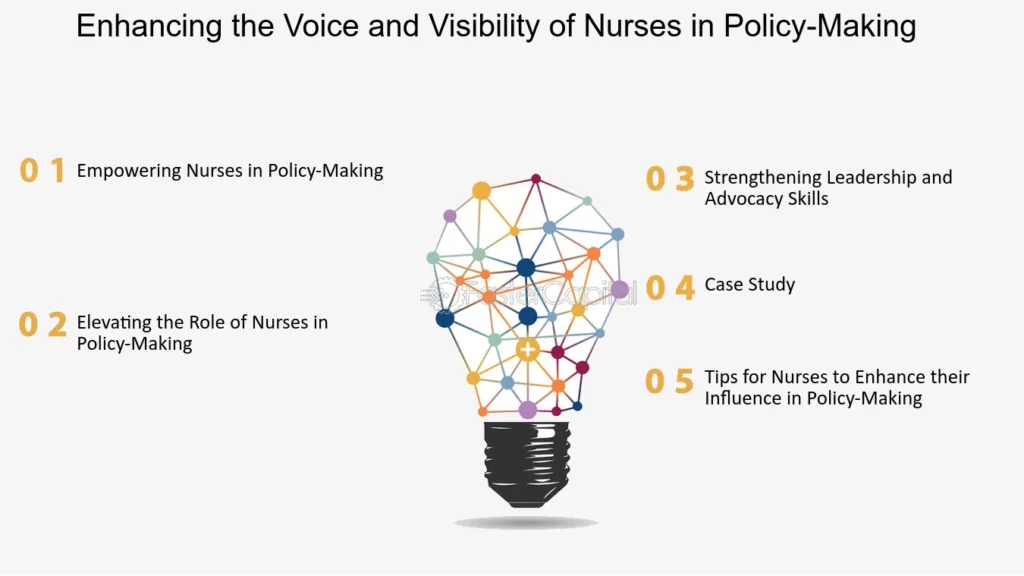In 2025, healthcare is evolving more rapidly than ever before. Amidst this transformation, nurses are not only frontline caregivers but are becoming powerful policy advocates. With deep insights into patient care, public health, and system inefficiencies, nurses are now taking the lead in shaping healthcare policy locally, nationally, and globally.
Nurses are no longer confined to hospital wards or community clinics. They are now speaking in legislative hearings, drafting reform proposals, influencing global health agendas, and sitting on policymaking boards. As healthcare systems grow increasingly complex, the role of the nurse as a change agent becomes indispensable.
This article explores how nurses are advocating for change in 2025, what policies they are shaping, the barriers they face, the strategies they use, and the future impact of their advocacy. It also highlights the growing need for leadership training, interdisciplinary collaboration, and policy education in nursing curricula to empower the next generation of nurse leaders.
In This Article
1. The Evolving Role of Nurses in 2025
Nurses in 2025 are more than caregivers they are leaders, researchers, educators, and policymakers. With their unique patient-centric perspective, they bridge clinical realities with policy decisions. They are driving reforms in:
- Health equity
- Workforce shortages
- Mental health
- Digital health technologies
- Universal healthcare access
Nurses now participate in think tanks, serve on government health panels, and lead nonprofit advocacy groups. They are often at the forefront of public health campaigns, lobbying for better staffing ratios, safe working conditions, and improved healthcare delivery systems.
2. Why Nurses are Vital to Policy Advocacy
1. Firsthand Experience
Nurses understand the consequences of poor health policies because they live them daily. This firsthand experience allows nurses to offer practical and people-centered solutions to policy gaps.
2. Large Workforce, Larger Voice
With over 29 million nurses worldwide, they represent the largest segment of healthcare workers. Their collective voice holds unmatched democratic legitimacy in healthcare decision-making.
3. Public Trust
Nurses consistently rank among the most trusted professions. This credibility gives their policy recommendations greater weight in public forums and among policymakers.
3. Key Areas Where Nurses Are Shaping Policy
In 2025, nurses are not just working in hospitals—they are shaping national and global health agendas. With their deep understanding of patient care and community health, nurses are influencing policies across critical sectors. Their advocacy ensures that healthcare policies are practical, equitable, and rooted in frontline experience. Here are the key areas where nurses are making a significant impact on policy today:
1. Mental Health and Wellbeing
Nurses are at the forefront of mental health reform. With rising awareness of psychological wellness, nurses advocate for increased mental health funding, improved access to therapy, and the integration of psychological services in primary care settings. They push for school-based programs, trauma-informed care, and mental health screenings in underserved areas. Their role in crisis response and suicide prevention strategies is helping reshape how governments address mental health nationwide.
2. Health Equity and Access
Health equity remains a top priority for nurse advocates. They push for policies that reduce disparities based on race, income, geography, and gender. Nurses working in rural and inner-city communities are lobbying for better access to primary care, preventive services, and maternal health programs. By highlighting the barriers faced by underserved populations, they guide policymakers toward inclusive, community-driven healthcare solutions.
3. Workforce Development and Nurse Staffing
One of the most urgent issues in 2025 is the global nursing shortage. Nurses are leading campaigns that demand better staffing ratios, fair compensation, and support for mental health and burnout recovery. They support policies that fund nurse recruitment programs, mentorship initiatives, and retention strategies—especially in high-risk and rural areas. Their advocacy ensures that nursing is seen as a sustainable, rewarding career.
4. Reproductive and Maternal Health
Nurse-midwives and reproductive health nurses are shaping policies on fertility, maternal rights, contraception, and abortion access. They advocate for respectful maternity care, expanded prenatal services, and safe delivery environments. Their evidence-based approach is critical in defending reproductive rights and promoting maternal health equity across different socioeconomic groups.
5. Public Health and Disease Prevention
Public health nurses influence policy decisions related to vaccination, pandemic preparedness, food safety, and chronic disease prevention. Their work during the COVID-19 crisis highlighted their role in managing outbreaks, promoting vaccine confidence, and educating communities. Today, they continue to advocate for policies that support community health programs, hygiene infrastructure, and school health initiatives.
6. Environmental Health and Climate Resilience
Nurses are increasingly involved in shaping policies that address the health impacts of climate change. They advocate for cleaner hospitals, sustainable medical waste disposal, disaster preparedness training, and policies that link environmental factors with public health outcomes. Environmental health nurses ensure that the intersection between climate and healthcare is no longer ignored.
From mental health to maternal rights and climate action, nurses are shaping healthcare policy with compassion, data, and real-world perspective. Their efforts in these key areas ensure that reforms are not only strategic but also empathetic and people-centred, creating a healthier future for all.
4. How Nurses Influence Policy: Tools & Tactics

In 2025, nurses are using smarter, more strategic tools to influence healthcare policy at every level. They are no longer passive participants but active policymakers, equipped with tactics that make real-world impact. From writing policy briefs to organising social movements, nurses are shaping the healthcare system through both institutional engagement and grassroots activism.
1. Legislative Advocacy
Nurses directly engage with lawmakers through legislative lobbying. They attend public hearings, offer testimony, and meet with representatives to present clinical insights that policymakers may lack. By providing stories backed by data, nurses make compelling cases for reforms in staffing, access to care, mental health services, and patient safety. Many work with national nursing associations to draft, support, or amend health-related bills.
2. Grassroots Organising
Grassroots movements are a powerful force in modern policy reform. Nurses mobilise communities by organising rallies, awareness events, and health camps. They build coalitions with patient groups, educators, and other healthcare professionals to amplify collective voices. This bottom-up pressure often influences legislators to act, especially when there’s strong community backing behind a proposed law.
3. Digital and Social Media Campaigns
Social media is a vital tool in the nurse advocate’s arsenal. Platforms like X (formerly Twitter), Facebook, LinkedIn, and Instagram allow nurses to raise awareness on key issues, launch petitions, and go viral with advocacy campaigns. Hashtags such as #NursesForChange and #SafeStaffingNow have helped push critical issues into mainstream conversations, drawing media and political attention.
4. Policy Writing and Research
Nurses are also involved in policy drafting and evaluation. Those with advanced training in public health or health administration contribute to creating white papers, policy position statements, and research briefs. These documents are often submitted to government panels, advisory boards, and institutional review committees to influence decision-making at structural levels.
5. Leadership in Professional Organisations
Membership in professional nursing organisations such as the American Nurses Association (ANA), Canadian Nurses Association (CNA), or International Council of Nurses (ICN)—empowers nurses to engage in collective advocacy. These bodies host policy summits, train nurse leaders in policy education, and lobby governments for system-wide changes.
6. Strategic Partnerships
To strengthen their influence, nurses often partner with physicians, lawyers, economists, and community leaders. This interdisciplinary collaboration allows them to present multi-angle solutions that are more attractive to policymakers. When nurses bring clinical experience, and partners bring legal or financial expertise, the policy proposal gains legitimacy and broader appeal.
7. Media Engagement
Nurses now appear in TV interviews, podcasts, webinars, and newspaper articles to speak on healthcare reform. Their media presence helps shape public opinion, influence debates, and prompt political action. A well-informed, articulate nurse on national media can reach millions and sway policy indirectly through public support.
By using a combination of these tools and tactics, nurses in 2025 are not just changing lives at the bedside they are rewriting healthcare policies from the ground up. Their voice is credible, their experience is irreplaceable, and their influence is only growing stronger.
5. Education, Training, and Leadership
To support advocacy roles, modern nursing education now includes:
- Health policy courses
- Leadership development
- Political science integration
- Ethics and public speaking
Many institutions also offer DNP and MSN programs with policy focus, preparing nurses to lead health policy units in hospitals, government, and NGOs.
6. Barriers Nurses Face in Policy Advocacy
While nurses play a growing role in healthcare policy, they still face numerous barriers that limit their influence and effectiveness in the policymaking arena. In 2025, even with increased recognition of their contributions, nurses often struggle against systemic, cultural, and institutional obstacles that prevent them from fully stepping into advocacy roles. Understanding these barriers is the first step in removing them.
1. Institutional Hierarchies and Power Imbalances
Healthcare systems are traditionally hierarchical, with doctors and administrators holding most of the decision-making authority. Despite being the largest group of healthcare professionals, nurses often find their voices undervalued in policy discussions. In many hospitals and healthcare organisations, policy matters are handled without adequate nursing representation, resulting in decisions that may not reflect the practical realities of frontline care.
2. Lack of Time and Resources
One of the most practical barriers nurses face is time. Long shifts, staffing shortages, and high patient loads leave little room for advocacy work. Many nurses are so overwhelmed with day-to-day responsibilities that engaging in policy initiatives feels like a luxury they can’t afford. Additionally, few healthcare systems allocate dedicated time or funding for nurses to participate in advocacy training or policy engagement.
3. Limited Policy Education and Training
Many nursing programs still focus heavily on clinical skills and not enough on health policy, leadership, or political advocacy. As a result, even experienced nurses may feel unprepared or intimidated by the policy world. Without adequate training, they may not know how to navigate government structures, engage with stakeholders, or influence legislation effectively.
4. Gender Bias and Societal Perceptions
Since the nursing profession is predominantly female, gender dynamics can also play a role in limiting policy influence. In many regions, nurses are still viewed as “support staff” rather than autonomous professionals with valuable insights. This perception is slowly changing, but the legacy of gender-based bias continues to affect nurses’ ability to gain leadership positions or be taken seriously in political discussions.
5. Underrepresentation in Decision-Making Bodies
Despite growing numbers, nurses remain underrepresented in key policy forums, healthcare boards, legislative health committees, and advisory councils. Without a seat at the table, their perspectives are often overlooked when policies are being developed or reviewed. This underrepresentation also means there are fewer nurse role models in high-level positions to inspire and mentor others in policy engagement.
6. Fear of Repercussions
In some healthcare environments, nurses who speak out on policy issues especially those related to patient safety or working conditions fear retaliation from employers. Concerns over job security, professional reputation, or conflict with management can deter even the most passionate advocates from voicing their opinions.
Despite these challenges, the resilience and determination of nurses are driving change. By raising awareness about these barriers, healthcare institutions, nursing organisations, and governments can implement strategies to support, educate, and empower nurses as policy leaders. In doing so, the system moves closer to truly patient-centred, inclusive, and effective healthcare governance.
7. Case Studies: Nurses Creating Real-World Impact
Case 1: Nurse-Led Legislation in California
In 2024, a coalition of nurses successfully campaigned for the Safe Staffing for Quality Care Act, mandating minimum nurse-to-patient ratios in all hospitals.
Case 2: Mental Health Reform in the UK
Mental health nurse advocates contributed to a landmark policy that brought psychological services into GP clinics, reducing wait times by 45%.
Case 3: Global Vaccine Equity
Nurses Without Borders led an international campaign pressuring wealthy nations to increase funding for global vaccine programs, resulting in expanded access for 12 developing countries.
8. Policy Advocacy in Action: Pandemic Lessons
COVID-19 highlighted gaps in healthcare systems. In 2025, nurses have used these lessons to advocate for:
- Pandemic preparedness policies
- Frontline worker protection laws
- Crisis mental health support
- Remote care infrastructure funding
Nurses also played a vital role in disseminating vaccine information, fighting disinformation, and encouraging community compliance with safety protocols.
9. Interdisciplinary Collaboration in Policymaking
Successful health policy requires multidisciplinary collaboration. Nurses now partner with:
- Doctors and specialists
- Lawmakers
- Social workers
- Health economists
- IT professionals
This cooperation ensures that policies are well-rounded, evidence-based, and ethically sound.
10. Technology and Digital Advocacy
In the digital age, nurses use tech for policy influence:
a. Social Media Campaigns
Hashtags like #NursesForChange and #HealthEquityNow garner millions of views.
b. Webinars and Virtual Summits
Virtual platforms allow nurses to educate communities and build coalitions beyond borders.
c. Digital Petitioning
Platforms like Change.org and Care2 host nurse-led petitions that gather hundreds of thousands of signatures.
d. Data Analytics
Nurse researchers use big data to demonstrate policy outcomes with quantifiable evidence—essential in swaying political decisions.
11. The Future of Nurse-Led Policy
By 2030, experts predict nurses will:
- Hold more political office
- Run national public health campaigns
- Lead international health organisations
- Drive climate-health agenda at global summits
- Be primary voices in AI and ethics in digital health
In essence, nurse advocacy is no longer optional it is a pillar of modern healthcare systems.
Must Read:
- Empowering Nurses: The Importance of Representation in Healthcare Leadership
- Legislative Advocacy: How Nurses Are Impacting State and Federal Healthcare Policies
- Flexible Staffing Models: The Future of Nurse Workforce Planning in 2025
12. Final Thoughts:
The healthcare landscape of 2025 is one of challenges and transformation. As chronic conditions rise, pandemics evolve, and health equity becomes a global demand, nurses stand at the centre of reform. Their voices, rooted in compassion, science, and experience, are more essential than ever.
The nursing profession is undergoing a powerful shift—from bedside care to boardroom influence. Nurse advocates today are ensuring that the patient’s voice is present in every decision that shapes our collective health.
But for nurse-led policy advocacy to truly thrive, several things must happen:
- Healthcare institutions must value and support nurses’ policy participation.
- Nursing schools must integrate policy and leadership education deeply.
- Governments must recognise and resource nurse-led initiatives.
- And nurses themselves must believe in their power to shape the world—not just treat its ailments.
By amplifying their voices, supporting their growth, and removing barriers to policy participation, we empower nurses not just to heal, but to transform the system itself. The future of healthcare doesn’t just need nurses it depends on them.
FAQs:
Q1. Why is nurse advocacy important in 2025?
Nurse advocacy ensures that healthcare policies reflect the real-world needs of patients and providers. Nurses bring evidence-based, compassionate, and practical insights to policymaking.
Q2. How can nurses get involved in policy change?
Nurses can join advocacy groups, attend legislative meetings, write to lawmakers, participate in campaigns, and engage with professional organisations offering policy training.
Q3. What are the biggest challenges nurses face in shaping policy?
Time constraints, institutional hierarchy, lack of representation, and gender biases are the top challenges nurses face in policy advocacy.
Q4. Are nurses holding political office in 2025?
Yes. More nurses are entering politics, especially at state and municipal levels, where they introduce and support healthcare reforms.
Q5. What education do nurses need to become policy advocates?
In addition to clinical training, nurses benefit from education in public health, political science, health economics, and leadership development.
Q6. What is the future of nurse-led healthcare policy?
The future includes greater participation in global health governance, AI ethics in nursing, digital health law, and climate-health policymaking.







